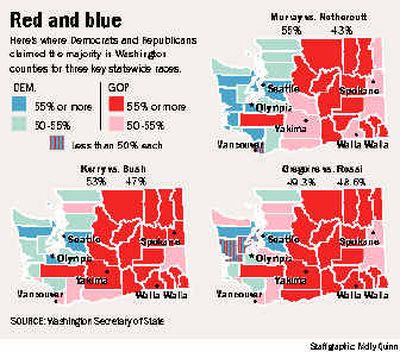Contests hinge on late count

The fate of several close contests for state and local office may hang on voters who cared enough to cast ballots on Tuesday but didn’t quite do it the way they were supposed to.
More than 6,000 provisional ballots in Spokane County and as many as 90,000 statewide are among the hundreds of thousands that will be counted around Washington in the coming weeks.
Provisional ballots are given to people who show up at a polling site but aren’t on the list of voters entitled to vote there. Many are absentee voters who say they have lost or ruined their mail-in ballots; others say they are registered elsewhere but can’t get there to vote.
For most candidates, those provisional ballots and the even larger numbers of absentee and mail-in ballots don’t matter.
The distance between first and second place in races for Washington’s U.S. Senate seat, Eastern Washington’s 5th District Congressional seat and Spokane County Commissioner District 1 seat is so wide that they are mathematically unlikely to change.
But the lead in the gubernatorial race between Republican Dino Rossi and Democrat Chris Gregoire changed hands several times Wednesday as different counties tabulated piles of absentee ballots. Gregoire was ahead at midnight, but Rossi took the lead after the rural counties reported their mail ballot tabulations in the morning and early afternoon. Gregoire moved ahead after King County counted some of its absentees in the late afternoon.
The gubernatorial race also provided a good example of how willing Washington voters are to “split” their ticket between the major parties’ candidates. Rossi polled far better than President Bush or Republican Senate candidate George Nethercutt.
Spokane County will count its first post-election batch of absentee ballots today. Watching those results closely along with Gregoire and Rossi will be Republican Mark Richard and Democrat Bill Burke, who are running for County Commissioner District 2, and Republican Brad Benson and Democrat Laurie Dolan, who are in a close race for the 6th Legislative District Senate position.
Richard is about 3,000 votes ahead of Burke, out of about 120,000 cast for that countywide race. Benson leads Dolan by about 1,050 votes out of 41,000 cast in the district. When the first batch of absentees was counted on Election Night, Dolan was ahead of Benson and Burke was ahead of Richard.
The city of Spokane’s street bond issue is also about 500 votes over the 60 percent super-majority it needs to pass, and could dip below that with a shift in the absentees.
Counting absentee ballots involves scanning a bar code on an envelope and checking the signature on that envelope with the signature on file before running the ballots through the computer. Spokane County Auditor Vicky Dalton estimated that as many as 45,000 absentee ballots will be counted through next week. The exact number depends on how many voters managed to get their ballots postmarked by Tuesday evening.
Counting provisional ballots is even more time consuming, Dalton said. Each provisional ballot is in an envelope with the would-be voter’s name and address. Election workers will search the election data bases for each name, and if they can find it, determine which races that voter was eligible to vote on.
If the voter is registered somewhere else in Spokane County, election workers mark a new ballot with the selections the voter is legally eligible to make.
If the voter is registered in another county, the ballot would be sent there, and provisional ballots cast elsewhere by voters registered in Spokane County would be sent here. Provisional ballots cast by voters registered in other states are sent to that state, and are handled under that state’s laws, Dalton said.
If the voter’s registration can’t be found, the ballot is discarded.
The final voter turnout also depends on the absentee and provisional ballots. Dalton estimated Wednesday county turnout would top 80 percent but might not hit earlier estimates of 85 percent. Although most poll sites experienced record crowds in the early morning through the mid afternoon, many saw a drop-off in the evening.
“The after-dinner rush didn’t happen,” she said. About two-thirds of voters registered to cast ballots at the polls, did so. Turnout among absentee voters may be as high as 90 percent, she added.